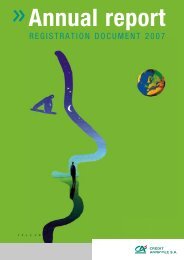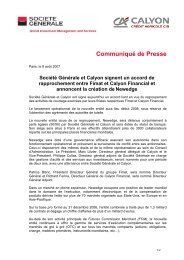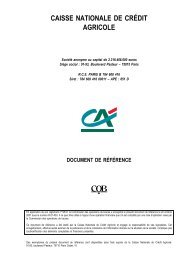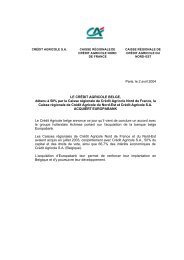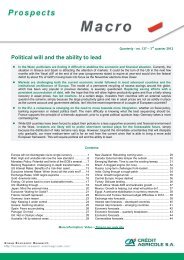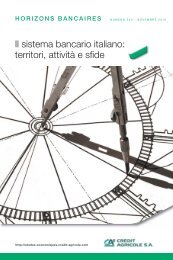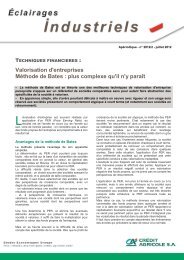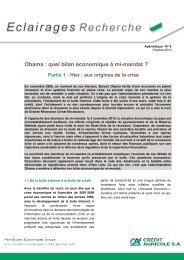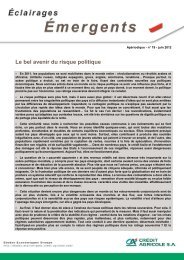PDF (3.77 Mo) - Le Crédit Agricole
PDF (3.77 Mo) - Le Crédit Agricole
PDF (3.77 Mo) - Le Crédit Agricole
Create successful ePaper yourself
Turn your PDF publications into a flip-book with our unique Google optimized e-Paper software.
Crédit <strong>Agricole</strong> S.A.Update of the 2011 registration document - A03Presentation of Crédit <strong>Agricole</strong> S.A. Group’s consolidated financialstatementsEconomic and financial environmentWith the escalating financial crisis in Greece, spreading to Spain and in particular to Italy, and the dominoeffects which transited through the banking system, the second half of 2011 was characterised by thegrowing severity of the sovereign debt crisis. Faced with an extremely challenging situation, the ECB’sdecision in December to fully open up the liquidity gates allowed for a return to relative calm on the markets,with two long-term refinancing operations with maturities of three years, coupled with more relaxed eligibilitycriteria for collateral and a further cut in interest rates (following that of November). In addition, politicalalternation in Greece and Italy, with the installation of two transitional governments headed by technocrats,was well received. In addition, the EU summit of 9 December set in stone budgetary discipline in theeurozone by setting “constitutional” limits for public deficits and reinforcing supervisory and sanctionmechanisms. Lastly, in February, with the signing of a further 130 billion euro aid in the framework of theEuropean support plan for Greece and the shaving of public debt granted by private creditors, fears aboutthe country leaving the eurozone were allayed.Budgetary restraint and monetary and financial orthodoxy remained at the heart of the strategy for finding asolution to the eurozone crisis, resulting in the joint purging of public, private and above all banks’ balancesheets, with detrimental consequences on growth.This was reflected by stagnation in eurozone GDP in the first quarter of 2012. While France managed to holdup with zero growth, Italy slid into recession with a fall of -0.8% in the first quarter of 2012 following -0.7% inthe fourth quarter of 2011. Economic activity also continued to decline in Spain (-0.3%) and Portugal (-0.1%).This contrasts strongly with Germany, which saw growth of 0.5% in the first quarter following a fall of -0.5%in the fourth quarter of 2011.This respite was only short-lived following the announcement in early March of the derailing of publicfinances in Spain, with a deficit representing 8.5% of GDP in 2011 compared with a target of 6%. Thisprompted the Spanish government to announce that the country would exceed the initial deficit target of4.4% for 2012, which was increased to 5.3% after negotiations with EU partners. At the time of the Aprilelections in Greece, the population’s forceful rejection of austerity policies, against the backdrop of adangerous rise of extremist and populist parties hostile to the Troika programme, also created turmoil in themarkets. A favourable outcome was finally reached pursuant to a second ballot that opened up the way forthe formation of a coalition government willing to pursue adjustment.However, the situation in Spain continued to cause concern on the markets. The forecast for growth wasrevised drastically by the authorities to -1.7% from +2.3% in 2012, and unemployment reached new peaklevels. The purge of the property market, which is far from over, has weakened the banks’ balance sheets,already tested by the need to comply with new Basel III regulations. These concerns were reflected by highsovereign risk premiums which sporadically topped the symbolic 7% mark which was the threshold fortriggering aid plans for Greece, Ireland and Portugal. Italy did not escape this contagion, with governmentbond rates also under pressure.The EU summit of 28 and 29 June was therefore held in a climate of acute of tension. In order to break thelinks of interdependence between sovereign and bank risks, the European Stability Mechanism (ESM) –which will replace the European Financial Stability Facility (EFSF) in December following the decision by theGerman constitutional court – has been authorised to grant direct financial aid to banks without having to gothrough governments, under the condition of the implementation of EU-wide banking supervision under theaegis of the ECB. 100 billion euros have also been allocated to Spain to strengthen its banking sector.Lastly, the capacity of European bailout funds to intervene in the debt markets has been reasserted.Against this backdrop of latent crisis, investors have remained highly cautious, as demonstrated by theextremely low level of risk-free rates (1.58% for 10-year government bonds in Germany and 1.65% in theUnited States at end-June). The euro has weakened considerably while the financial crisis, in affecting twoeurozone heavyweight countries, has changed in scale and therefore nature, becoming more systemic.Changes to accounting principles and methodsChanges to accounting principles and methods are described in Note 1 to the interim condensedconsolidated financial statements at 30 June 2012.Page 71 sur 237



